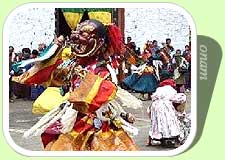Kaikottikali or Thiruvathirakali
Kaikottikali, also known as thiruvathirakali, is a very popular, graceful and symmetric group-dance of the women of Kerala often performed during festive seasons like Thiruvathira and Onam.
The actor recites stories from the epics (based on Sanskrit text) interpreting them in Malayalam, enlivening his narration with Thandava dance rhythms and also gestures and bodily postures which are clearly derived from Natya Sastra.
It is a simple and gentle dance with the lasya element predominating, even though the thandava part is also brought in occasionally, when men also participate as seen in some parts of the Malabar area. Typically dressed in Kerala style with mandu and neriyathu and the hairbun bedecked with jasmine garlands the women dance in gay abandon, singing melodious Thiruvathira songs which are well-reputed for their literary flourish. One of the performers sing the first line of a song while the rest repeat it in chorus, clapping their hands in unison. Moving in a circle, clockwise and at time anticlockwise, at every step they gracefully bend sideways, the arms coming together in beautiful gestures, upwards and downwards and to either side, in order to clap
This blog is your one-stop guide to the most renowned religious landmarks and captivating festivals across the globe. Embark on a virtual pilgrimage to discover the architectural wonders, sacred spaces, and cultural experiences that ignite faith and inspire millions.
Sunday, August 13, 2006
onam dances--Kaikottikali
Onam festival of kerala --Thumbi Thullal
Thumbi Thullal
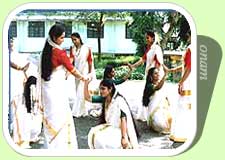 Thumbi Thullal is a fascinating all women dance and singing event performed in Kerala on the occasion of Onam. While men engage themselves in energetic sports, womenfolk perform Thumbi Thullal and have their share of fun.
Thumbi Thullal is a fascinating all women dance and singing event performed in Kerala on the occasion of Onam. While men engage themselves in energetic sports, womenfolk perform Thumbi Thullal and have their share of fun.Wearing their best sarees, stunning jewelery and fragrant gajras, a group of women sit in the formation of circle to play Thumbi Thullal. In the centre of the circle sits the main performer.
Lead singer initiates a song in her melodious voice by singing the first couplet which is taken up by other women. The sequence continues song after song with the lead singer initiating the couplet every time followed by a chorus from other women. Joyful clap dance also goes on in rhythm with the singing.
It is a colorful spectacle to watch women in their carefree mood. The event continues amidst jeers and laughter till the day comes to its end.
Onam festival of kerala--Pulikali
Pulikali is a colorful recreational folk art from the state of Kerala. It is performed by trained artists to entertain people on the occasion of Onam.
Pulikali, also known as Kaduvaakali, is a 200 year old art, carefully preserved by the artists of the state. Literal meaning of Pulikali is the 'play of the tigers' hence the performance revolve around the theme of tiger hunting. The folk art is mainly practiced in Thrissur (Trichur) and Palghat districts of Kerala. Best place to watch the show is Swaraj Ground at Thrissur on the fourth day of Onam, where Pulikali troupes from all over the district assemble to display their skills.


The Appearance
Striking feature of this folk art is the colorful appearance of the performers. To get the semblance of a tiger artists paint themselves in bright yellow with patterns of black and red. A tiger mask on the face completes the get up.
It is a painstaking job and artists spend a whole night prior to the performance day on their make-up. Patience of artists must be appreciated, as most paints contain toxic chemicals which create a burning sensation when applied on newly shaved bodies.
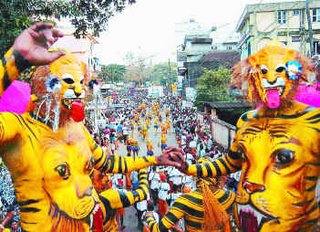
The Play
It is a wonderful sight to see humans in the guise of tigers roaming in the streets. Children, specifically take great delight in their performance as the entertainers dance, pounce and walk like a tiger. Scenes of tiger hunting goats and tiger being hunted by a human beings are also beautifully depicted by them. Beat for the dance movement is provided by percussion instruments like 'udukku' and 'thakil'. The Swaraj Round in Thrissur district is the venue of a grand Pulikali on the fourth Onam day. On this day Pulikali troups from different parts of the district come here to perform.
Onam festival of kerala--Kummatti kali
Kummatti kali - The Mask Dance
Most interesting facet of Kummattikali is a peculiar way in which Kummati performers clad themselves. They don a heavily painted colourful wooden mask depicting faces of Krishna, Narada, Kiratha, Darika or hunters. These masks are usually made out of saprophyte, jack fruit tree, Alstonia Scholaris, Hog Plum tree or the Coral tree.
Dancers wear skirts woven out of plaited grass. Some performers cover their whole body with bunches of grass for a more bushy appearance. The semblance is made more joyful with the 'talla' attached externally to the mask giving the appearance of a toothless open mouth. Dancers also hold and manipulate long sticks of residuary agricultural produce called 'Kummattikali', it is from this that the dance derives its name. Their dance is related to Shaiva myth. 'Thamma' (an old woman) walks in front with the help of a stick. Thamma is symbolic of mother of every being and everything.
Rhythm for the dance movements is provided by vibrating the string of a bow like instrument called onavillu. Arecanut wood is used to make the bow and the strings are beaten with a narrow bamboo stick.
Kummatti dancers are a sight to watch as they move around from house to house collecting jaggery, rice, or small amounts of cash. Onlookers, specially children take great delight in their performance.
Themes of Kummattikali are mostly taken from the stories of Ramayana, Darika Vadham, the story of Shiva and folk tales like Manjan Nayare Pattu.
It may be noted that folk art of Kerala can be classified into two broad categories - ritualistic and non-ritualistic. Ritualistic can be further divided into - Devotional, performed to please a particular god and goddess and Magical Art Forms. Theyyam, Thira, Poothamthira, Kanyarkali, Kummattikali, etc. are some of devotional art forms.
Kummatti dances are more rampant in Trichur District, during Onam. Pristine or original form of Kummattikali can be seen in the Bhadrakali temple in Palghat district.
ONAM--FESTIVAL OF KERALA --Pookalam
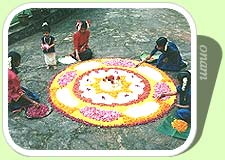
Pookalam is an intricate and colourful arrangement of flowers laid on the floor. Tradition of decorating Pookalam is extremely popular in Kerala and is followed as a ritual in every household during ten-day-long Onam celebrations.
'Pookhalam' consists of two words, 'poov' meaning flower and 'kalam' means colour sketches on the ground. It is considered auspicious to prepare Pookalam, also known as 'Aththa-Poo' during the festival of Onam.
People believe the spirit of their dear King Mahabali visits Kerala at the time of Onam. Besides making several other arrangements, people, especially adolescent girls prepare elaborate Pookalams to welcome their most loved King.
Making of a Pookalam
Kilo and kilos of flowers, lot of dedication, creativity, technique and team effort are the basic essential of an eye catching Pookkalam.
Athapoovu are usually circular in shape and multi-tiered colourful arrangements of flowers, petals and leaves. Use of powder colours, desiccated coconut or artificial flowers is prohibited. Pookalams are normally laid on the front court yard of the house. Idols of Mahabali and Vishnu are placed in the center of the Pookalam and worshiped. Diameter of a Pookalam normally ranges from four to five meters.
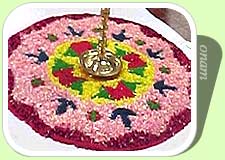 Ritual of making the flower mats continues for all ten days of Onam. Designing starts from the day of Atham and is made ready by Thiruvonam day. Basic design is prepared on the first day. Size of a Pookalam is increased by adding more to it on every passing day hence a massive Pookalam gets ready for the main day of the occasion. Its a big creative task, as designers have to think of a new design ever day.
Ritual of making the flower mats continues for all ten days of Onam. Designing starts from the day of Atham and is made ready by Thiruvonam day. Basic design is prepared on the first day. Size of a Pookalam is increased by adding more to it on every passing day hence a massive Pookalam gets ready for the main day of the occasion. Its a big creative task, as designers have to think of a new design ever day.Various flowers are used on each day as a specific flower is dedicated to each day of Onam. Commonly used flowers include Thumba (Lucas Aspera), Kakka Poovu, Thechipoovu, Mukkutti (little tree plant), Chemparathy (shoe flower), Aripoo or Konginipoo (Lantana), Hanuman Kireedom (Red pagoda plant) and Chethi (Ixora). Of all these flowers, Thumba flowers are given more importance in Pookalam as they are small in size and glitter in the the soft rays of the sun. 'Thumba Poo' is also considered to be the favourite flower of Lord Shiva and King Mahabali was a devout worshipper of Shiva.
On the next day of Onam, Thumba flowers are used to decorate Onapookalam. The arrangement is not touched for the next 15 days. On the 15 th day, called 'Ayilyam', Pookalam is decorated again. On the next day, called Magam, Pookalam is given a cut in its four corners with a knife. This marks the end of Pookalam decorations for the year. Some also follow the tradition of erecting a small pandal over the completed flower carpet and decorating it with colourful festoons.
Making of Pookalam is itself a colourful and joyous event. Being a team effort it helps to generate feeling of togetherness and goodwill amongst the people. It is animating to watch women as they prepare Pookalam while singing traditional songs. Giggling and sharing jokes between the thought provoking and back breaking job.
 Trends
TrendsEarlier, people used to make efforts to collect flowers for designing a Pookalam. Children used to get up early in the morning and gather flowers in their small 'Pookuda' (basket) from the village gardens. These days, the trend has changed and people have the option of buying flowers from the market in the shape and colour of their choice.
Pookalam decoration competitions are organised by various societies and groups all over the state on the day of Onam. They have become extremely popular and witness huge public participations. Big prizes are also kept in these contests as they have turned up to be extremely competitive events. A large number of people assemble just to have a look at the innovative and meticulously prepared art pieces.
A beautiful design, though it is said, is created in the heart, use of technology is also in vogue in designing of a Pookalam. People prepare design first on computer and then implement it on floor. This saves a lot of time and energy and helps the designers to come up with stunning Pookalams.
MORE ONA-POOKALAM


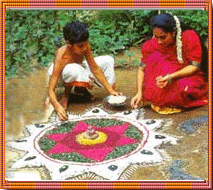



ONAM--SPECIAL RECIPES
Sarkarapuratty (Fried Bananas Chips in Molasses)
Ingredients :
|
|
Method of Preparation : 
Peel the bananas and split it into two pieces. Cut it into 1/4" thick pieces. Fry it in warm coconut oil.
Heat the molasses in 1/4glass of water. Remove from fire when it becomes thick. Add dried ginger powder and fried banana pieces in this molasses solution. Keep stirring till the banana pieces separates.
Kaya Varuthathu (Banana Fry)
Ingredients :
- Semi ripe banana - 1
- Coconut oil - 150gm
- Turmeric powder - 1/4tsp
- Salt - to taste
Method :
Peel banana and slice into thin round pieces or split bananas into 4 thin pieces and slice. Heat oil and fry the banana pieces. When it is 3/4 done, add turmeric powder and salt mixed in 1tsp water. Fry well.
READ MORE-->

